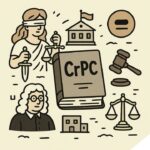Code
(1) Every charge under this Code shall state the offence with which the accused is charged.
(2) If the law which creates the offence gives it any specific name, the offence may be described in the charge by that name only.
(3) If the law which creates the offence does not give it any specific name, so much of the definition of the offence must be stated as to give the accused notice of the matter with which he is charged.
(4) The law and section of the law against which the offence is said to have been committed shall be mentioned in the charge.
(5) The fact that the charge is made is equivalent to a statement that every legal condition required by law to constitute the offence charged was fulfilled in the particular case.
(6) The charge shall be written in the language of the Court.
(7) If the accused, having been previously convicted of any offence, is liable, by reason of such previous conviction, to enhanced punishment, or to punishment of a different kind, for a subsequent offence, and it is intended to prove such previous conviction for the purpose of affecting the punishment which the Court may think fit to award for the subsequent offence, the fact, date and place of the previous conviction shall be stated in the charge; and if such statement has been omitted, the Court may add it at any time before sentence is passed.
Illustrations
(a) A is charged with the murder of B. This is equivalent to a statement that A’s act fell within the definition of murder given in sections 299 and 300 of the Indian Penal Code (45 of 1860); that it did not fall within any of the general exceptions of the said Code; and that it did not fall within any of the five exceptions to section 300, or that, if it did fall within Exception 1, one or other of the three provisos to that exception applied to it.
(b) A is charged under section 326 of the Indian Penal Code (45 of 1860), with voluntarily causing grievous hurt to B by means of an instrument for shooting. This is equivalent to a statement that the case was not provided for by section 335 of the said Code, and that the general exceptions did not apply to it.
(c) A is accused of murder, cheating, theft, extortion, adultery or criminal intimidation, or using a false property-mark. The charge may state that A committed murder, or cheating, or theft, or extortion, or adultery, or criminal intimidation, or that he used a false property-mark, without reference to the definitions, of those crimes contained in the Indian Penal Code (45 of 1860); but the sections under which the offence is punishable must, in each instance be referred to in the charge.
(d) A is charged under section 184 of the Indian Penal Code (45 of 1860) with intentionally obstructing a sale of property offered for sale by the lawful authority of a public servant. The charge should be in those words.
Explain it
The charge sheet, which is a formal document presented by the police before the court, must clearly outline the allegations against the accused. It must contain the following information:
- The specific offence alleged to have been committed by the accused.
- The date, time and place of the alleged offence.
- A brief description of the facts constituting the offence.
- The name and address of the accused person, if known.
- The names and addresses of the witnesses who can testify against the accused.
- A list of the documents that are relevant to the case.
The purpose of this section is to ensure that the accused is fully informed of the charges against them and has an opportunity to prepare their defence.
Illustrate it
Suppose a person is accused of theft. The charge sheet should clearly state:
- The offence: Theft (Section 379 of the Indian Penal Code)
- Date, time, and place of the alleged theft (e.g., 10th January 2023, 10:00 AM, XYZ store)
- Brief description of facts: Accused stole a mobile phone from the store
- Name and address of the accused
- Names and addresses of witnesses (e.g., store owner, security guard)
- Relevant documents (e.g., CCTV footage, store inventory records)
Common Questions and Answers
Q: Can the police change the charge sheet after it is filed?
A: Yes, but only with the permission of the court. The court may allow amendments to the charge sheet if there is a compelling reason and the accused is not prejudiced by the change.
Q: What happens if the charge sheet does not contain all the required information?
A: The court may reject the charge sheet and direct the police to file a fresh one containing all the necessary details.








